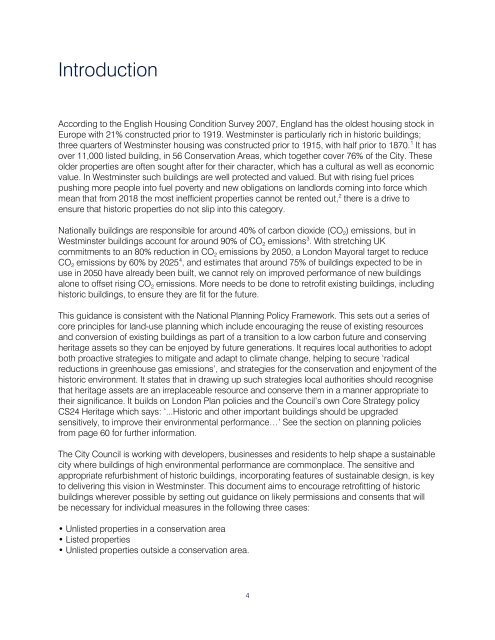Retrofitting Historic Buildings - Westminster City Council
Retrofitting Historic Buildings - Westminster City Council
Retrofitting Historic Buildings - Westminster City Council
Create successful ePaper yourself
Turn your PDF publications into a flip-book with our unique Google optimized e-Paper software.
IntroductionAccording to the English Housing Condition Survey 2007, England has the oldest housing stock inEurope with 21% constructed prior to 1919. <strong>Westminster</strong> is particularly rich in historic buildings;three quarters of <strong>Westminster</strong> housing was constructed prior to 1915, with half prior to 1870. 1 It hasover 11,000 listed building, in 56 Conservation Areas, which together cover 76% of the <strong>City</strong>. Theseolder properties are often sought after for their character, which has a cultural as well as economicvalue. In <strong>Westminster</strong> such buildings are well protected and valued. But with rising fuel pricespushing more people into fuel poverty and new obligations on landlords coming into force whichmean that from 2018 the most inefficient properties cannot be rented out, 2 there is a drive toensure that historic properties do not slip into this category.Nationally buildings are responsible for around 40% of carbon dioxide (CO 2 ) emissions, but in<strong>Westminster</strong> buildings account for around 90% of CO 2 emissions 3 . With stretching UKcommitments to an 80% reduction in CO 2 emissions by 2050, a London Mayoral target to reduceCO 2 emissions by 60% by 2025 4 , and estimates that around 75% of buildings expected to be inuse in 2050 have already been built, we cannot rely on improved performance of new buildingsalone to offset rising CO 2 emissions. More needs to be done to retrofit existing buildings, includinghistoric buildings, to ensure they are fit for the future.This guidance is consistent with the National Planning Policy Framework. This sets out a series ofcore principles for land-use planning which include encouraging the reuse of existing resourcesand conversion of existing buildings as part of a transition to a low carbon future and conservingheritage assets so they can be enjoyed by future generations. It requires local authorities to adoptboth proactive strategies to mitigate and adapt to climate change, helping to secure ‘radicalreductions in greenhouse gas emissions’, and strategies for the conservation and enjoyment of thehistoric environment. It states that in drawing up such strategies local authorities should recognisethat heritage assets are an irreplaceable resource and conserve them in a manner appropriate totheir significance. It builds on London Plan policies and the <strong>Council</strong>’s own Core Strategy policyCS24 Heritage which says: ‘...<strong>Historic</strong> and other important buildings should be upgradedsensitively, to improve their environmental performance…’ See the section on planning policiesfrom page 60 for further information.The <strong>City</strong> <strong>Council</strong> is working with developers, businesses and residents to help shape a sustainablecity where buildings of high environmental performance are commonplace. The sensitive andappropriate refurbishment of historic buildings, incorporating features of sustainable design, is keyto delivering this vision in <strong>Westminster</strong>. This document aims to encourage retrofitting of historicbuildings wherever possible by setting out guidance on likely permissions and consents that willbe necessary for individual measures in the following three cases:• Unlisted properties in a conservation area• Listed properties• Unlisted properties outside a conservation area.4
















